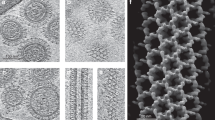Abstract
INFECTIVE ribonucleic acids have been obtained from several animal viruses by the cold phenol method described by Gierer and Schramm1. In general, however, most of the experiments have been done with crude suspensions, and it has not always been clear whether the infective ribonucleic acid was derived from the virus itself or from a viral precursor or other related material. The work of Huppert and Sanders2 with mouse encephalomyocarditis virus has shown clearly that the infective ribonucleic acid which can be obtained from mouse carcinoma cells infected with this virus has its origin in a viral precursor and not in the virus itself. In fact, infective ribonucleic acid cannot be extracted from this virus by the cold phenol method. On the other hand, it is likely that the infective material which can be obtained from suspensions of tissues infected with the viruses of poliomyelitis3, mouse encephalomyelitis4, Mengo encephalitis5, Murray Valley encephalitis6 and foot-and-mouth disease7,8 by this method is being derived from the viruses themselves. This difference in behaviour emphasizes the differences in the chemical structures of the viruses. Furthermore, the work of Wecker9 has shown that purified Western equine encephalomyelitis virus, which does not yield any infective ribonucleic acid on treatment with cold phenol, can be made to do so if the extraction is carried out at 40–50° C.
This is a preview of subscription content, access via your institution
Access options
Subscribe to this journal
Receive 51 print issues and online access
$199.00 per year
only $3.90 per issue
Buy this article
- Purchase on Springer Link
- Instant access to full article PDF
Prices may be subject to local taxes which are calculated during checkout
Similar content being viewed by others
References
Gierer, A., and Schramm, G., Nature, 177, 702 (1956).
Huppert, J., and Sanders, F. K., Nature, 182, 515 (1958).
Koch, G., Koenig, S., and Alexander, H. E., Virology, 10, 329 (1960).
Franklin, R. M., Wecker, E., and Henry, C., Virology, 7, 220 (1959).
Colter, J. S., Bird, H. H., Moyer, A. W., and Brown, R. A., Virology, 4, 522 (1957).
Ada, G. L., and Anderson, G. S., Nature, 183, 799 (1959).
Brown, F., and Stewart, D. L., Virology, 7, 408 (1959).
Mussgay, M., and Strohmaier, K., Zbl. Bakt., I, Orig., 173, 163 (1958).
Wecker, E., Virology, 7, 241 (1959).
Harding, J. D. J., Done, J. T., and Kershaw, G. F., Vet. Rec., 69, 824 (1957).
Chaproniere, D. M., Done, J. T., and Andrewes, C. H., Brit. J. Exp. Path., 39, 74 (1958).
Kohn, J., Nature, 183, 1055 (1959).
Author information
Authors and Affiliations
Rights and permissions
About this article
Cite this article
BROWN, F., STEWART, D. Infective Ribonucleic Acid from the Viruses of Talfan and Teschen Diseases. Nature 187, 714–715 (1960). https://doi.org/10.1038/187714a0
Issue Date:
DOI: https://doi.org/10.1038/187714a0
This article is cited by
-
Biophysical studies of teschen disease virus (Talfan strain)
Archiv f�r die gesamte Virusforschung (1967)
Comments
By submitting a comment you agree to abide by our Terms and Community Guidelines. If you find something abusive or that does not comply with our terms or guidelines please flag it as inappropriate.



